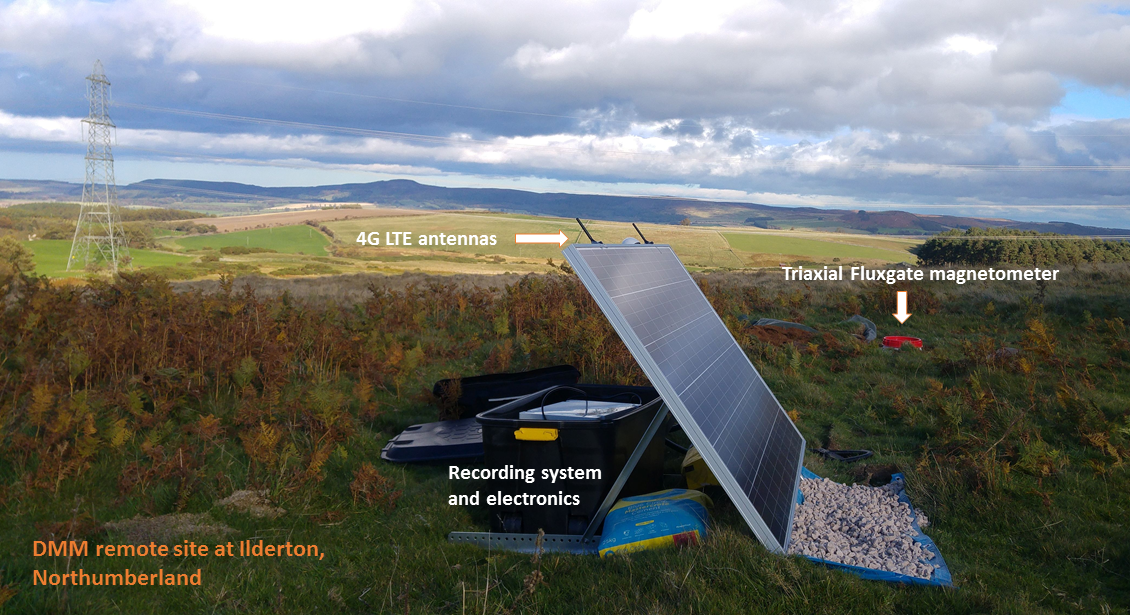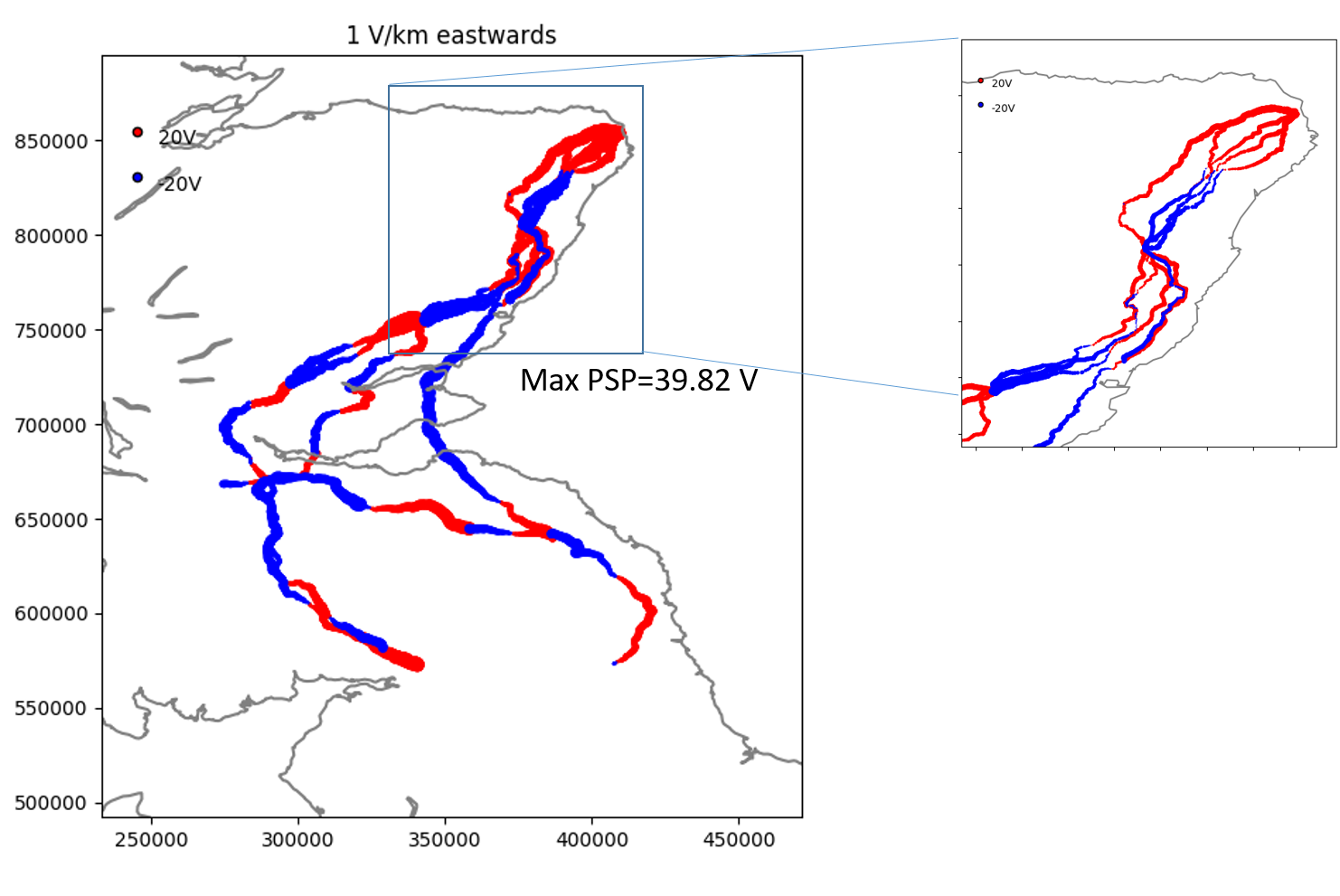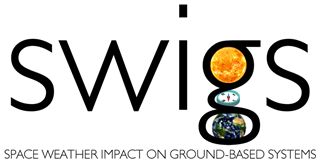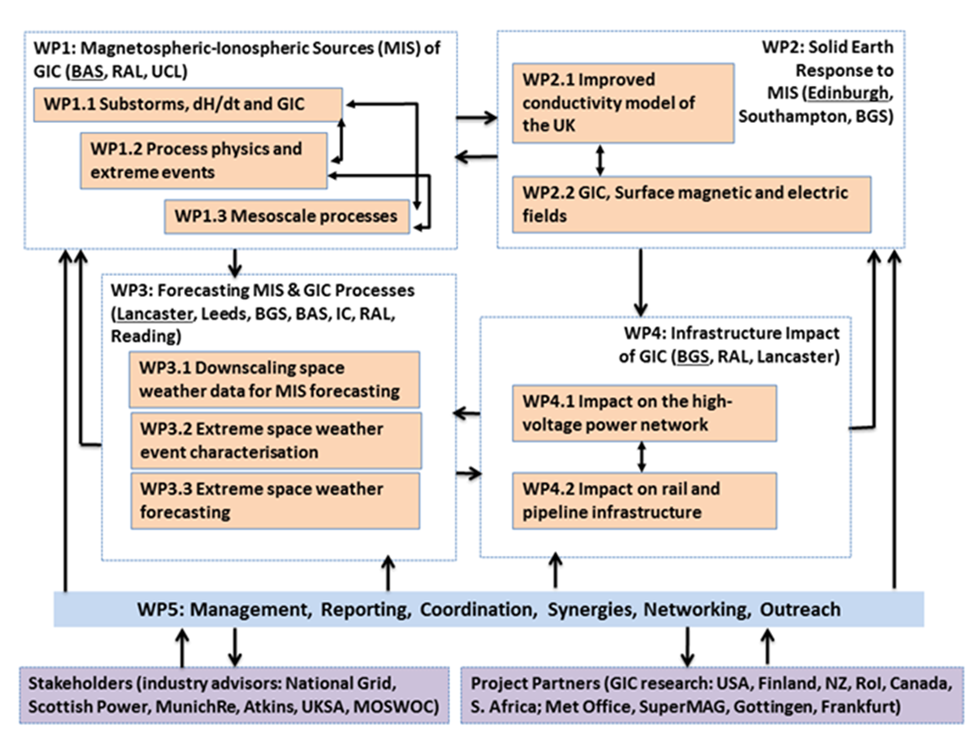What are the research goals of SWIGS?
Background
Severe space weather is known to pose a significant hazard to ground based technologies, such as electrical transmission systems, pipelines and railways. Space weather is a consequence of solar magnetic activity that is carried to Earth in the Solar Wind, where it impacts the electrical currents and electromagnetic fields in near-Earth space and in the upper atmosphere. As a result of Faraday's law of induction, varying electrical currents in space cause a varying magnetic field at ground level, which induces a surface electric field in the Earth. This electric field acts as a 'battery' between earthing points in conducting structures, causing Geomagnetically Induced Currents (GIC) to flow to and from the ground through such networks.
GIC are a documented hazard to the continuous, safe and efficient operation of high voltage power transformers, as well as a cause of increased corrosion rates in metal pipelines and a disruptor of safe signal operations within railway networks. Estimates of potential economic loss from severe space weather run into billions of dollars per day. This is a result of our interconnected society's increasing dependence on various technologies, including electrical power, and the impact that, for example, power loss can have on economic and other activities within and between nations.
Existing models of GIC in UK ground-based networks are inadequate in the details (e.g. only the highest power grid voltages are modelled; networks are only connected at the substation level; no models or studies of impact on UK pipelines or railways exist). Models are also incomplete in terms of source field specification or modelling (e.g. measured magnetic data from sparse networks; limited forward modelling of magnetic variations; dependence on poorly-known sub-surface electrical conductivity). Models in operational use in the UK have limited validation against surface electric field or GIC measurements and contain no forecast capability.
WP1: Magnetospheric-Ionospheric Sources (MIS) of GIC (BAS, RAL, UCL)
At the outer edge of our atmosphere mega-amp electrical currents are flowing, generated by space weather and causing the aurora. Rapid variations of these currents can induce unwanted currents to flow in electricity supply networks, such as the U.K.’s National Grid. These are known as geomagnetically-induced currents or GICs for short. Extreme GICs have the potential to cause costly damage and service interruption. Consequently, we need to understand the physics of the space weather processes that cause the most hazardous GICs. In this workpackage we will answer three main questions:
• Are extreme space weather currents different to the norm? By definition they’re certainly bigger, but do they flow in new or different ways, or saturate?
• How important are substorms? Typically several times a day this space weather phenomenon creates some of the strongest electrical currents in space but do they create the most hazardous GICs in electricity supply networks?
• Are big or little current systems the greatest hazard? Some evidence suggests that smaller-scale currents in space are hazardous but we don’t understand them very well – How are they caused? Can they be predicted from the large-scale currents that we understand and can predict better?
These questions will be answered using data collected by spacecraft operated by the European Space Agency, NASA, and others, and from international networks of instruments on the ground. The outcome will help focus work on developing models and other tools to forecast and mitigate the effects of GICs on the National Grid and other electricity supply networks around the world.

A substorm breakup aurora in which intense electrical currents flow, which may be hazardous to electricity supply networks. Photo courtesy of Annika Seppala, University of Otago, New Zealand.
WP2: Solid Earth Response to MIS (BGS, Edinburgh, Southampton)
The electric fields on the ground that cause GICs are generated by geomagnetic activity and heavily depend on the electrical conductivity of the soil and rocks of the Earth.
The currently used model of electrical conductivity for the UK is based on near-surface studies and knowledge about the deeper geology. In workpackage 2 we are active in different field campaigns using a deep electro-magnetic sounding technique called magnetotellurics (MT) to investigate the electrical conductivity model of the British islands and
the Differential Magnetometer Method (DMM) to perform proxy-GIC measurements in high-voltage powerlines. We will use these new data to verify and improveour computer models.

Differential Magnetometer site close to a powerline in Northumberland. The systems consist of two magnetometers recording the variations in the magnetic fields due to GICs flowing in the powerlines. They are remotely connected via 4G network to the data centre in Edinburgh.
WP3: Forecasting MIS and GIC processes (BAS, BGS, Imperial, Lancaster, Leeds, RAL, Reading)
Potentially damaging geomagnetically induced currents (GIC) are caused by variations in the magnetic field at the surface of the Earth. These fluctuations can occur on timescales from seconds to minutes and are driven by the interaction of the solar wind with the Earth’s internally generated magnetic field. Various industries require better and timely forecasts of GIC and we aim to improve our understanding and forecasting of processes and extremes in the space environment and the solid Earth.

The EISCAT ionospheric radar facility, located near Tromsø, Norway [credit: M.J. Kosch].
- WP4: Infrastructure Impact of GIC (BGS, Lancaster, RAL)
The aims of work package 4 are to understand the impact that space weather events have on the ground through better models and investigation of the main types of infrastructure at risk. We are looking at the effects on the UK pipeline network through simulation, the occurrence of space weather related anomalies in the rail network and the correlation of geomagnetic storms with the increase in dissolved gases in high voltage transformers. We are working closely with work package 2 to make measurements of GIC in the HV power network and compare them to the estimates from our computer model of the grid.

GIC in the Scottish gas pipeline network for a geoelectric field of 1 V/km in an eastward direction.
- WP5: Management of Outputs, Reporting, Coordination and Outreach (BGS, WP leads)



